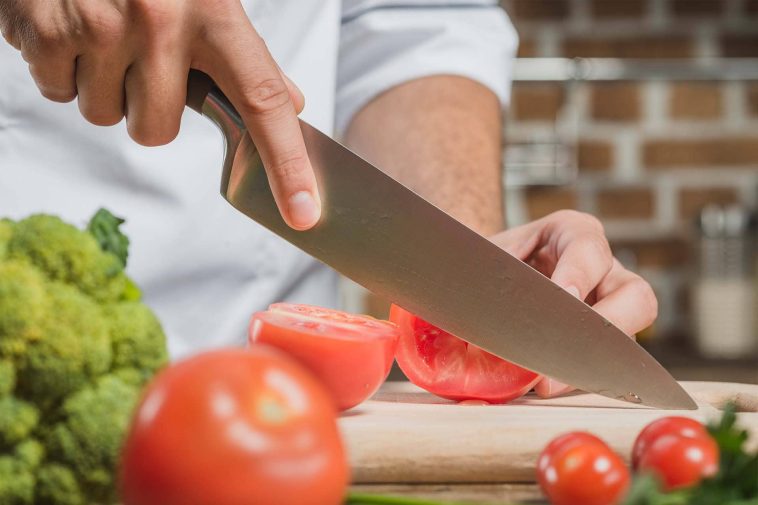In the culinary world, the importance of selecting the right knives cannot be overstated. A well-chosen knife not only enhances the cooking experience but also ensures precision and safety. This guide delves into seven essential types of knives, each serving a unique purpose in the kitchen. From the versatile Chef’s Knife to the precise Paring Knife, and the specialized Bread Knife, we cover a range of tools that cater to various culinary needs. Understanding the distinct features and uses of these knives will equip you with the knowledge to choose the right knife for every task, elevating your cooking to a new level of efficiency and enjoyment.
Chef’s Knife
The Chef’s Knife is a cornerstone in the kitchen, known for its versatility. Ideal for tasks like chopping vegetables, slicing meat, and mincing herbs, this knife is an all-purpose tool. Key features include:
- A blade typically 8 to 10 inches long.
- A curved edge to facilitate a rocking motion for efficient chopping.
- A balanced weight distribution for ease of use.
When selecting a chef’s knife, consider the blade material and handle comfort. For care, regular sharpening and proper storage are crucial to maintain its edge and longevity.
Paring Knife
The Paring Knife is essential for intricate tasks where precision is key. Its characteristics include:
- A short blade, usually 2-4 inches.
- A sharp point for detailed work like peeling fruits or deveining shrimp.
Its small size allows for better control, making it perfect for tasks that require finesse. To maintain its sharpness, regular honing and careful storage are recommended.
Bread Knife
The Bread Knife is uniquely designed to handle bread and other soft foods without crushing them. Its features include:
- A long, serrated blade that cuts through bread with ease.
- Typically 8-10 inches in length.
This knife is not just for bread; it’s also ideal for foods with tough exteriors and soft interiors, like tomatoes. The serrated edge requires less frequent sharpening, but when needed, it should be done by a professional.
Utility/Petty Knife
The Utility or Petty Knife is a versatile addition to the kitchen, filling the gap between a chef’s knife and a paring knife. Its features include:
- A medium-length blade, around 4-7 inches.
- Slimmer than a chef’s knife but larger than a paring knife.
This knife is ideal for tasks that are too small for a chef’s knife but too large for a paring knife, like slicing vegetables and cutting sandwiches. Regular sharpening and proper storage will keep it in good condition.
Santoku Knife
The Santoku Knife, originating from Japan, is designed for versatility and efficiency. It features:
- A flat edge and a sheep’s foot blade that curves down at the tip.
- A blade length typically between 5-7 inches.
This knife excels in slicing, dicing, and mincing, making it ideal for preparing meat, fish, and vegetables. Its design allows for thin, precise cuts, and the wide blade helps in scooping up chopped ingredients. The Santoku knife is a go-to for cooks who prefer a lighter, more balanced knife for quick, repetitive chopping.
Nakiri Knife
The Nakiri Knife is a Japanese knife specifically designed for cutting vegetables. Its features include:
- A straight edge and a squared-off tip.
- A thin, uniform blade, perfect for precise vegetable chopping.
This knife is a favorite among vegetarians for its ability to make clean, straight cuts, ideal for slicing and dicing all types of vegetables. The Nakiri knife’s design ensures minimal friction with the food, preserving the freshness and integrity of vegetables, making it a valuable tool for plant-based cooking.
Gyuto Knife
The Gyuto Knife is the Japanese counterpart to the Western chef’s knife, with some distinct differences:
- It typically has a thinner and sharper blade.
- The blade length ranges from 7-12 inches, similar to the Western chef’s knife.
Ideal for a range of tasks, from slicing meat to chopping vegetables, the Gyuto knife offers a lighter and more precise cutting experience. Its sharper edge and balanced design make it a preferred choice for chefs looking for precision and agility in their knife work.
Steak Knife
A Steak Knife is essential for efficiently cutting through cooked meat. Key aspects include:
- Options between serrated and non-serrated blades.
- A sharp, typically 4-6 inch blade.
Serrated steak knives are excellent for tougher meats, as their saw-like blades cut without tearing. Non-serrated options, on the other hand, offer cleaner cuts and are ideal for tender meats. While serrated knives require less frequent sharpening, non-serrated knives offer a smoother cut but need regular maintenance. The choice between the two often comes down to personal preference and the type of meat typically served.
FAQs
How often should knives be sharpened?
- Knives should be sharpened every few months, depending on usage. A sharp knife is safer and more efficient.
Can these knives be washed in a dishwasher?
- It’s best to hand wash knives to maintain their edge and prevent handle damage.
What is the safest way to store knives?
- Use a knife block, magnetic strip, or sheath to store knives safely and protect their edges.
Are there any safety tips for using knives?
- Always cut away from your body, keep knives sharp, and use a stable cutting surface.
Conclusion
Understanding the importance of different types of knives is crucial in elevating your cooking experience. Each knife, with its unique design and purpose, contributes to the efficiency and enjoyment of culinary preparation. The right selection of knives not only enhances the quality of your dishes but also ensures safety and precision in the kitchen. Investing in a variety of knives tailored to specific tasks will undoubtedly enrich your cooking journey, making every slice, dice, and chop a step towards culinary excellence.






Comments
Loading…